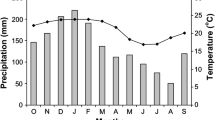Abstract
The phenology of tree components of natural forests occurring between 350 and 2150 m in Kumaun Himalaya is descibed. All forests had more evergreen than deciduous taxa. The degree of evergreenness increased with increasing elevation and decreasing summer dryness. For most species (including all dominants) concentrated leafdrop and simultaneous leafing occurred during the warm-dry period of the year. About half of the species showed multiple leafing.
All species had a sharp flowering peak in April. Wet-season flowering was rare. Most of the species flowered synchronously. In the sal- (Shorea robusta) and pine (Pinus roxburghii) forests a single peak of fruit maturation occurred in summer, while in other forests there also was a secondary peak in autumn.
Similar content being viewed by others
References
Borchert, R., 1980. Phenology and Ecophysiology of Tropical Trees: Erythrinia poeppigiana O.F. Cook. Ecology 61: 1065–1074.
Bray, J. R. & Curtis, J. T., 1957. An ordination of the upland forest communities of southern Wisconsin. Ecol. Monogr. 27: 325–349.
Curtis, J. T. & McIntosh, R. P., 1950. The interrelations of certain analytic and synthetic phytosociological characters. Ecology 31: 438–455.
Frankie, G. W., Baker, H. G. & Opler, P. A., 1974. Comparative phenological studies of trees in tropical wet and dry forests in lowlands of Costa Rica. J. Ecol. 62: 881–919.
Kramer, P. J. & Kozlowski, T. T., 1979. Physiology of woody plants. Academic Press, New York. San Francisco, London. 811 pp.
Lieth, H., ed. 1974. Phenology and seasonality modeling Springer-Verlag-Berlin. Heidelberg, New York. 444 pp.
Longman, K. A. & Jenik, J., 1974. Tropical forest and its environment. Longman. London and New York. 196 pp.
Mueller-Dombois, D. & Ellenberg, H., 1974. Aims and methods of vegetation ecology. John Wiley & Sons, New York. 547 pp.
Murray, C. & Miller, P. C., 1982. Phenological observations of major plant growth forms and species in montane and Eriphorum virginatum tussock tundra in Central Alaska. Holarctic Ecol. 5: 109–116.
Opler, P. A., Frankie, G. W. & Baker, H. G., 1980. Comparative phenological studies of treelet and shrub species in tropical wet and dry forests in the lowlands of Costa Rica. J. Ecol. 68: 167–188.
Osmaston, A. E., 1926. A forest flora for Kumaon. Intern. Book Distributors, Dehra Dun. 605 pp.
Pandey, U. & Singh, J. S. 1981. A quantitative study of the forest floor, litter fall and nutrient return in an oak-conifer forest in Himalaya. I. Composition and dynamics of forest floor. Oecol. Gen. 2: 49–61.
Poole, R. W. & Rathcke, B. J., 1979. Regularity, randomness, and aggregation in flowering phenologies. Science. 203: 470–471.
Ralhan, P. K., Saxena, A. K. & Singh, J. S., 1982. Analysis of forest vegetation at and around Naini Tal in Kumaun Himalaya. Proc. Indian natn. Sci. Acad. B 48, 1: 121–137.
Saxena, A. K. & Singh, J. S., 1982a. A phytosociological analysis of woody species in forest communities of a part of Kumaun Himalaya. Vegetatio 50: 3–22.
Saxena, A. K. & Singh, J. S., 1982b. Quantitative profile structure of certain forests in the Kumaun Himalaya. Proc. Indian Acad. Sci. (Plant Sci.) 91(6): 529–549.
Singh, J. S. & Chaturvedi, O. P., 1982. Photosynthetic pigments on plant bearing surfaces in Himalayas. Photosynthetica. 61(1): 101–114.
Singh, J. S. & Singh, S. P., 1984. An Integrated Ecological Study of Eastern Kumaun Himalaya with Emphasis on Natural Resources. Kumaun University, Naini Tal, India. Final report submitted to the Department of Science and Technology, New Delhi. 2: 379 pp.
Tewari, J. C., 1982. Vegetational analysis along altitudinal gradient around Naini Tal. Ph.D. Thesis, Kumaun University, Naini Tal. 570 pp.
Thornthwaite, C. W., 1931. The climates of North America; according to a new classification. Geographical Review 21: 633–655.
Troup, R. S., 1921. The silviculture of Indian trees. I–III. Clarendon Press. Oxford. 1195 pp.
Upreti, N., 1982. A study on phytosiciology and state of regeneration of oak forests at Naini Tal. Ph.D. Thesis, Kumaun University, Naini Tal. 481 pp.
Valdiya, K. S., 1980. Stratigraphic scheme of the sedimentary units of the Kumaun Lesser Himalaya. In: K. S. Valdiya & S. B. Bhatia (eds.) Stratigraphy and correlations of the Lesser Himalayan formations. Hindustan Publ. Corp., Delhi: 7–48.
Author information
Authors and Affiliations
Additional information
Nomenclature generally follows Osmaston (1926), the authority is given where the species is mentioned first.
Financial support from the Department of Science and Technology, Government of India, is grategully acknowledged. We thank Dr. Y. P. S. Pangtey and Dr. J. C. Tewari for their help respectively in plant identification and ordination.
Rights and permissions
About this article
Cite this article
Ralhan, P.K., Khanna, R.K., Singh, S.P. et al. Phenological characteristics of the tree layer of Kumaun Himalayan forests. Vegetatio 60, 91–101 (1985). https://doi.org/10.1007/BF00040351
Accepted:
Issue Date:
DOI: https://doi.org/10.1007/BF00040351




